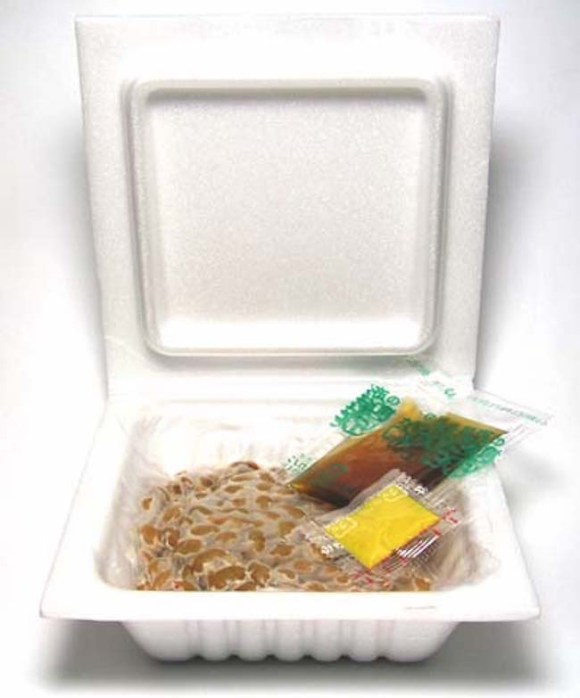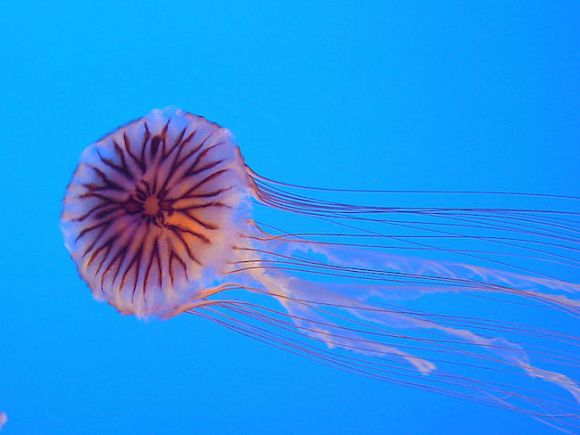
Surfers could be at greater risk of developing an allergy to natto, a Japanese study has found. And the unlikely culprit is thought to be jellyfish stings.
Natto, the sticky fermented soy beans that are as as polarising as Marmite, is a traditional and common Japanese food. Allergy to natto is rare, but research from Yokohama City University Hospital suggests it could be more prevalent in people who spend a lot of time in the water and have been repeatedly stung by jellyfish.
Dr. Naoko Inomata at Yokohama City University Hospital studied the lifestyle habits and sporting history of 18 patients who had been treated for natto allergy at the hospital’s Department of Dermatology since 2004. Of the natto allergy patients, 12 were surfers, two were scuba divers, and one was a professional diver. That means over 80 percent of the (admittedly small) study group regularly spent long amounts of time in the ocean.
▼ Natto allergy is very rare. And the food is really good for you, although it’s not for everyone.
So what’s causing people who spent time in the ocean to become allergic to natto? Well, the substance that gives natto its unique stickiness is polyglutamic acid, which is also found in jellyfish tentacles. So, Dr Inomata believes that repeated stings by jellyfish could cause more surfers and divers to develop natto allergy. “So, if it’s thought that a patient is allergic to natto, doctors should find out if they do marine sports,” she said.
▼ However, taking up surfing just to get out of eating natto is probably a step too far.
Sources: Yomiuri yomidr, zaeega
Featured image:Wikipedia/Ishikawa Ken
Top image: Megumi Natto



 Soap made from natto coming to Tokyo a week after Natto Day
Soap made from natto coming to Tokyo a week after Natto Day We spice up our fermented soybeans with curry powder flavored natto【Taste Test】
We spice up our fermented soybeans with curry powder flavored natto【Taste Test】 Toast with fermented soybeans and honey may not be good-looking, but it is good eating
Toast with fermented soybeans and honey may not be good-looking, but it is good eating Natto for beginners? How to half-make Japanese fermented soybeans at home【SoraKitchen】
Natto for beginners? How to half-make Japanese fermented soybeans at home【SoraKitchen】 Check if you have a soba allergy with these amazing ukiyoe-print temporary tattoos!
Check if you have a soba allergy with these amazing ukiyoe-print temporary tattoos! How to order snacks on a Shinkansen bullet train in Japan
How to order snacks on a Shinkansen bullet train in Japan Demon Slayer: Kimetsu no Yaiba gets new roller coaster attractions and food at Universal Studios Japan
Demon Slayer: Kimetsu no Yaiba gets new roller coaster attractions and food at Universal Studios Japan Nintendo history you can feel – Super NES, N64, and GameCube controllers become capsule toys
Nintendo history you can feel – Super NES, N64, and GameCube controllers become capsule toys New Nintendo Lego kit is a beautiful piece of moving pixel art of Mario and Yoshi【Photos】
New Nintendo Lego kit is a beautiful piece of moving pixel art of Mario and Yoshi【Photos】 Japan’s new difficult-to-drink-from beer glass protects your liver, but it’s a brutal experience
Japan’s new difficult-to-drink-from beer glass protects your liver, but it’s a brutal experience A visit to the best UFO catcher arcade in the universe!
A visit to the best UFO catcher arcade in the universe! To combat declining birth rate, Japan to begin offering “Breeding Visas” to foreigners
To combat declining birth rate, Japan to begin offering “Breeding Visas” to foreigners Tokyo Station’s perfect breakfast spot might just be this izakaya Japanese-style pub
Tokyo Station’s perfect breakfast spot might just be this izakaya Japanese-style pub Sex doll sharing service shut down by Chinese authorities
Sex doll sharing service shut down by Chinese authorities High-fashion Totoro cuddle purse is like an elegant stroll in the forest【Photos】
High-fashion Totoro cuddle purse is like an elegant stroll in the forest【Photos】 Hello, cosmetics! Clinique teams up with Hello Kitty this summer for first-time collaboration
Hello, cosmetics! Clinique teams up with Hello Kitty this summer for first-time collaboration “The most Delicious Cup Noodle in history” – Japan’s French Cup Noodle wins our heart【Taste test】
“The most Delicious Cup Noodle in history” – Japan’s French Cup Noodle wins our heart【Taste test】 Starbucks releases a cute Frappuccino and Unicorn Cake…but not in Japan
Starbucks releases a cute Frappuccino and Unicorn Cake…but not in Japan Kyoto Tower mascot termination reveals dark side behind cute Japanese characters
Kyoto Tower mascot termination reveals dark side behind cute Japanese characters McDonald’s Japan’s Soft Twist Tower: A phantom ice cream only sold at select branches
McDonald’s Japan’s Soft Twist Tower: A phantom ice cream only sold at select branches Yabai Ramen: What makes this Japanese ramen so dangerous?
Yabai Ramen: What makes this Japanese ramen so dangerous? Finally! Nintendo Japan expands Switch 8-bit controller sales to everybody, Online member or not
Finally! Nintendo Japan expands Switch 8-bit controller sales to everybody, Online member or not Japanese government wants to build luxury resorts in all national parks for foreign tourists
Japanese government wants to build luxury resorts in all national parks for foreign tourists 10 things you should buy at 7-Eleven in Japan
10 things you should buy at 7-Eleven in Japan Studio Ghibli releases anime heroine cosplay dresses that are super comfy to wear
Studio Ghibli releases anime heroine cosplay dresses that are super comfy to wear Woman charged for driving suitcase without a license in Osaka
Woman charged for driving suitcase without a license in Osaka Studio Ghibli unveils My Neighbour Totoro miniature house model
Studio Ghibli unveils My Neighbour Totoro miniature house model Kyoto experiencing problems with foreign tourists not paying for bus fares, but not on purpose
Kyoto experiencing problems with foreign tourists not paying for bus fares, but not on purpose Fighting mild hunger with a Japanese soda that turns into jelly in the stomach【Taste test】
Fighting mild hunger with a Japanese soda that turns into jelly in the stomach【Taste test】 Studio Ghibli’s Howl’s Moving Castle tapestry unveiled in Japan for first time
Studio Ghibli’s Howl’s Moving Castle tapestry unveiled in Japan for first time McDonald’s new Happy Meals offer up cute and practical Sanrio lifestyle goods
McDonald’s new Happy Meals offer up cute and practical Sanrio lifestyle goods Sales of Japan’s most convenient train ticket/shopping payment cards suspended indefinitely
Sales of Japan’s most convenient train ticket/shopping payment cards suspended indefinitely Sold-out Studio Ghibli desktop humidifiers are back so Totoro can help you through the dry season
Sold-out Studio Ghibli desktop humidifiers are back so Totoro can help you through the dry season Japanese government to make first change to romanization spelling rules since the 1950s
Japanese government to make first change to romanization spelling rules since the 1950s Foreigner’s request for help in Tokyo makes us sad for the state of society
Foreigner’s request for help in Tokyo makes us sad for the state of society Ghibli founders Toshio Suzuki and Hayao Miyazaki contribute to Japanese whisky Totoro label design
Ghibli founders Toshio Suzuki and Hayao Miyazaki contribute to Japanese whisky Totoro label design Doraemon found buried at sea as scene from 1993 anime becomes real life【Photos】
Doraemon found buried at sea as scene from 1993 anime becomes real life【Photos】 Tokyo’s most famous Starbucks is closed
Tokyo’s most famous Starbucks is closed Princesses, fruits, and blacksmiths: Study reveals the 30 most unusual family names in Japan
Princesses, fruits, and blacksmiths: Study reveals the 30 most unusual family names in Japan Natto Boys want to take their smelly beans to Africa, but they need your help
Natto Boys want to take their smelly beans to Africa, but they need your help Portuguese man-of-war creating beaches of sadness in Japan with its terrible toxic tentacles
Portuguese man-of-war creating beaches of sadness in Japan with its terrible toxic tentacles Genetically altered rice could solve Japan’s pollen allergy problem
Genetically altered rice could solve Japan’s pollen allergy problem New product stirs your natto 424 times to bring out its ultimate flavor
New product stirs your natto 424 times to bring out its ultimate flavor Eat Japanese cuisine like an epicure with the updated Ultimate NTO natto mixer from Takara Tomy
Eat Japanese cuisine like an epicure with the updated Ultimate NTO natto mixer from Takara Tomy All-you-can-eat stinky fermented soybeans come to Ginza, if that’s your thing
All-you-can-eat stinky fermented soybeans come to Ginza, if that’s your thing We try a new natto coffee ice cream that took 17 months to perfect
We try a new natto coffee ice cream that took 17 months to perfect We try ice cream with a topping of natto fermented soybeans, because the Internet told us to
We try ice cream with a topping of natto fermented soybeans, because the Internet told us to A pack of natto (fermented Japanese soybeans) a day keeps the death away according to study
A pack of natto (fermented Japanese soybeans) a day keeps the death away according to study Osaka doctor wins Ig Nobel Prize for discovering kisses can reduce allergic reactions
Osaka doctor wins Ig Nobel Prize for discovering kisses can reduce allergic reactions Our natto maniac verifies the legitimacy of fermented soybean-flavored potato chips【Taste test】
Our natto maniac verifies the legitimacy of fermented soybean-flavored potato chips【Taste test】 Life hack for living in Japan: How to painlessly remove the wrapper from a pack of natto
Life hack for living in Japan: How to painlessly remove the wrapper from a pack of natto Fermented soybean shaved ice pushes the envelope of summertime sweets
Fermented soybean shaved ice pushes the envelope of summertime sweets Custard pudding with natto fermented soybeans? We try the new dessert craze sweeping Japan
Custard pudding with natto fermented soybeans? We try the new dessert craze sweeping Japan Mizkan develops world’s most “beautiful” natto, Mr. Sato takes it for a spin
Mizkan develops world’s most “beautiful” natto, Mr. Sato takes it for a spin New magic powder purports to make natto edible even for bean-haters
New magic powder purports to make natto edible even for bean-haters
Leave a Reply